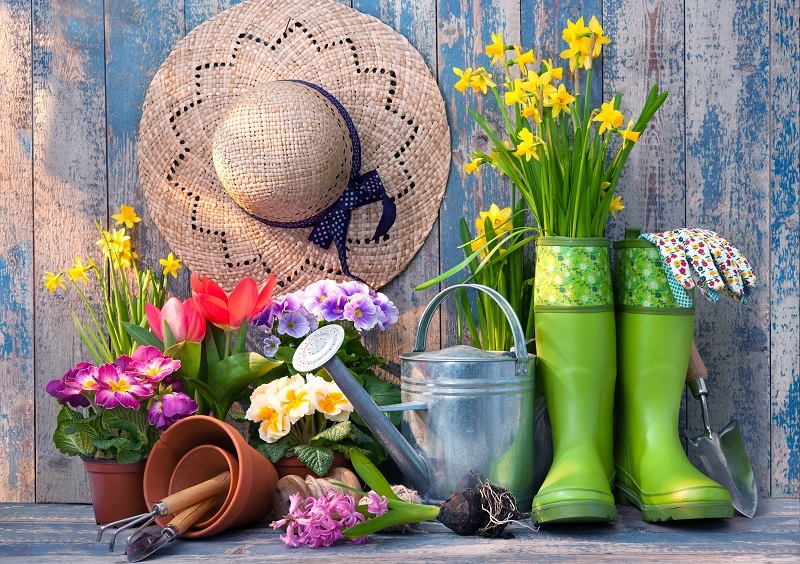A Comprehensive Guide to Poinsettia Care and Longevity
Posted on 18/08/2025
A Comprehensive Guide to Poinsettia Care and Longevity
Poinsettias (Euphorbia pulcherrima) are beloved holiday plants, gracing homes, businesses, and festive gatherings with their vibrant red, pink, cream, or even variegated bracts. While many people view these beauties as disposable decorations, with the proper care, poinsettias can thrive for months--and even years! This comprehensive guide will walk you through every step of poinsettia care and provide valuable tips for ensuring longevity and repeat bloom.
Understanding the Poinsettia Plant
Native to Mexico and Central America, poinsettias have become synonymous with the winter holiday season. Their colorful "flowers" are actually bracts--modified leaves--surrounding small, yellow, true flowers known as cyathia. Proper poinsettia maintenance not only preserves their beauty throughout the holidays but can also encourage them to rebloom year after year.
Poinsettia's Natural Habitat
- Warm, frost-free environments
- Bright, indirect light
- Well-draining, slightly acidic soil
Understanding a poinsettia's native habitat is essential for replicating ideal conditions in your home. This foundational knowledge ensures you support their full lifespan, not just their holiday magic.

Buying Healthy Poinsettias
Before you can master poinsettia care, start with a healthy plant. When selecting a plant, look for the following characteristics:
- Vivid, unblemished bracts: Colors should be rich and free from brown spots or wilting.
- Glossy, dark green leaves: Indicate vitality. Avoid plants with yellowing or drooping foliage.
- Intact cyathia: The small, true flowers at the center should be tight and not shedding pollen (which signals maturity and decline).
- Potting soil that isn't soggy or bone-dry.
Be gentle when transporting poinsettias in winter. Even brief exposure to cold or drafts can damage the plant. Wrap it in paper or plastic and move it quickly from store to car to home.
Optimal Poinsettia Location in Your Home
Once home, placement is crucial for poinsettia longevity:
- Light: Place your poinsettia in a spot with plenty of bright, indirect sunlight (at least six hours a day). Windowsills with filtered light are ideal.
- Temperature: Maintain indoor temperatures between 65?F and 75?F (18?C-24?C) during the day and not below 60?F (15?C) at night.
- Humidity: Poinsettias prefer humidity levels of 40-60%. Dry air (common in homes with heating systems) can shorten their lifespan. Mist lightly or place the pot on a humidity tray to compensate.
- Draft-free zones: Avoid placing plants near heating vents, radiators, fireplaces, or doors that open to the outside.
Choosing the right location is vital for poinsettia health, preventing leaf drop and prolonging color.
Watering Your Poinsettia
One of the most common causes of early poinsettia decline is improper watering. Here's how to water your plant for maximum poinsettia longevity:
- Check the soil daily; water when the top 1-2 inches (2.5-5 cm) of soil are dry.
- Water thoroughly until it drains from the bottom, but never let the plant sit in standing water.
- Remove foil or wrapping from the pot if necessary to allow proper drainage and avoid root rot.
- Reduce watering frequency in cooler rooms or for older plants.
Tip: Overwatering and underwatering both cause leaves to yellow and drop. Always err on the side of slightly dry soil for these drought-tolerant plants.
Fertilizing Poinsettias for Health and Growth
During the holiday display period, fertilizing is not required. However, if you plan to keep your poinsettia past the holidays and encourage future blooms, regular feeding is key:
- Begin fertilizing monthly in the spring after the blooms fade, using a balanced, water-soluble houseplant fertilizer (such as 20-20-20 or equivalent).
- Avoid feeding during the fall and winter display period.
- Resume monthly feeding as new growth appears after annual pruning.
Fertilization supports sturdy growth and robust bracts, crucial for long-term poinsettia care.
Pruning and Rejuvenating Your Poinsettia
Proper pruning is essential for controlling the plant's size, encouraging bushier growth, and preparing for rebloom:
- After the holidays (usually March or April), when the bracts fade, cut stems back to 4-6 inches (10-15 cm).
- Remove dead or weak growth to focus energy on healthy stems.
- During spring and summer, pinching back new shoots regularly encourages a fuller, more compact shape.
Don't forget to use gloves when pruning, as poinsettias exude a milky sap that can be skin-irritating to some individuals.
Repotting Poinsettias
As your plant matures, it may outgrow its pot. Repot in late spring (after pruning) if:
- Roots are visible at the bottom or circling the pot
- Growth appears stunted and the soil dries out rapidly
Choose a pot a couple of inches wider than the original, and use fresh, well-draining potting mix.
Getting Your Poinsettia to Rebloom
Perhaps the biggest challenge--and reward--of poinsettia care for longevity is inducing rebloom. Poinsettias are short-day plants, meaning they need extended darkness to set color. Follow these steps to encourage the return of those festive bracts:
Annual Poinsettia Bloom Cycle
- Late Winter/Early Spring (MarchApril): Cut back and reduce watering. Allow some leaf drop and let the plant rest.
- Late Spring: Repot if needed, resume regular watering and monthly feeding. Place outdoors in a shaded spot once frost risk passes.
- Summer: When the weather is reliably warm, give your plant at least 6 hours of filtered sun per day. Pinch tips regularly until early August.
- September/October: Bring inside before night temps dip below 60?F (15?C).
- October 1st to Thanksgiving: For 8-10 weeks, place the plant in total darkness for at least 14 continuous hours every night (for example, in a closet or box), and bright indirect light during the day. Maintain temperatures of 65-75?F. Continue normal watering and feeding schedule.
- Late November/December: Bracts should begin coloring up. End the dark treatment once fully colored and enjoy your rebloomed poinsettia!
Consistency is essential! Even one night of light interruption during the darkness period can delay or prevent reblooming.
Common Issues and Solutions in Poinsettia Care
To maximize poinsettia longevity, avoid these common pitfalls:
Pest Problems
- Whiteflies and spider mites: Watch for sticky residue or stippled leaves. Rinse foliage or use insecticidal soap if needed.
- Fungus gnats: Allowed soil to dry slightly between waterings to prevent larvae.
Environmental Stresses
- Leaf drop: Usually caused by drafts, cold exposure, or root rot from soggy soil.
- Faded bracts: Insufficient light or temperature fluctuations can accelerate fading.
- Wilting: Most commonly due to underwatering; adjust schedule as needed.
Are Poinsettias Poisonous?
Contrary to popular myth, poinsettias are not highly toxic to humans or pets. The sap can cause mild irritation, and consuming large amounts may result in stomach upset, but significant harm is rare. Keep out of reach of curious children and pets, and use gloves when pruning to avoid potential rash.
Extending Poinsettia Display Life
If your goal is simply to keep your plant vibrant from Thanksgiving to New Year's (or longer), focus on these essential poinsettia care tips:
- Avoid overwatering and ensure good drainage
- Keep temperatures consistent (avoid sudden chills or heat spikes)
- Provide bright but indirect sunlight
- Mist as needed to combat dry winter air
- Remove faded or yellow leaves promptly
With the right care, poinsettias may retain their beauty for months!
Creative Reuse: Beyond the Holidays
Poinsettias can be reintegrated into your indoor or outdoor plant collection long after the holidays. Once the danger of frost has passed, healthy plants can thrive outdoors in containers or garden beds in mild climates. With regular pruning and feeding, they may grow into attractive green houseplants, bursting with color in subsequent winters.

Frequently Asked Questions About Poinsettia Care and Longevity
- How long can a poinsettia live?
Poinsettias are perennial tropical shrubs and, with excellent care, may live--and rebloom--for years. - Why are my poinsettia leaves turning yellow or dropping?
The most common causes are overwatering, cold drafts, or insufficient light. - Can I plant my poinsettia outdoors?
In USDA zones 9-11, established plants can be acclimated to outdoor gardens after last frost, growing several feet tall over time. - Does my poinsettia need pruning?
Yes! Annual pruning after bloom fades rejuvenates growth and ensures bushy, healthy plants. - How do I get my poinsettia to turn red again?
Shorter days and longer nights (14+ hours of total darkness) in fall will trigger bloom. Careful timing and planning are crucial for success.
Conclusion: Your Path to Long-Lasting Poinsettias
Poinsettias are more than just festive seasonal decor--they're robust plants with the potential for year-round enjoyment. With the guidance in this comprehensive poinsettia care guide, you can keep yours thriving well past the holidays and even encourage beautiful reblooms in future years. Remember to:
- Provide plenty of bright, indirect sunlight
- Maintain warm temperatures and avoid drafts
- Water carefully and avoid standing water
- Prune, repot, and fertilize as needed
- Use proper darkness treatment for rebloom
Whether you want your poinsettias to shine for weeks or many seasons, the secret to poinsettia longevity truly is attentive and informed care. Celebrate their brilliant colors, master their rebloom, and enjoy the joy they bring year after year!
Latest Posts
Achieve Long-Lasting Poinsettia Beauty with Minimal Effort
8 Compelling Facts You Never Knew About Sunflowers
Three Simple Tricks to Keeping Your Flowers Looking Fresh







